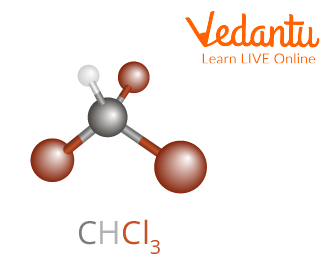




Chloroform - A Brief Description
Chloroform is also known as trichloromethane or methyl trichloride. It was prepared in 1831 by a known chemist Dr. Samuel Guthrei. Generally, chloroform is helpful because the solvent is a substance that helps different substances to dissolve. It is used for preparing chlorofluorocarbons.
Consistent with medical science, chronic exposure to chloroform may produce dizziness, fatigue, drowsiness, memory impairment, etc. The structure of chloroform is obtained by substituting three chlorine atoms in place of three hydrogen atoms in methane molecules.
What is Chloroform?
Chloroform is a volatile and colourless kind of liquid. It is a trichloromethane derivative with a smell similar to ether. It is an organic compound with the formula CHCl3. Many kinds of seaweed produce chloroform and fungi are believed to produce chloroform in soil, and thus are natural sources of chloroform.
Properties of Chloroform
Physical Properties of Chloroform
Chloroform has the following physical properties:
It is a sweet-smelling colourless liquid.
It’s rationally insoluble in water but dissolves in organic solvents like alcohol and ether etc.
It is non-ignitable however its vapours may burn with green flame.
It evaporates very quickly with exposure to air.
Table: Physical Properties of Chloroform
Chemical Properties of Chloroform
Chloroform has the following chemical properties:
In alkaline media, the reaction of chloroform with acetone is very explosive.
Chloroform reacts with bases like NaOH and forms sodium acetate and water.
CHCl3 + 4NaOH → HCOONa + 3NaCl + 2H2O
Chloroform in the air breaks down at prolonged speed and its breakdown products in the air include phosgene and hydrogen chloride which are very toxic compounds.
In humans, it affects the central nervous system directly.

Molecular Structure of Chloroform
Preparation of Chloroform
Chloroform is prepared in the laborator by heating ethanol with bleaching powder. The reaction is called the haloalkane reaction. When a paste of chlorinated lime is heated with ethanol, chloroform is obtained. The reaction takes place in following steps :
Step 1 : CaOCl2(bleaching powder) + H2O→Cl2 + Ca(OH)2
Step 2: Chlorine thus acts as both oxidising and chlorinating agent. It first oxidises alcohol into aldehyde and then chlorinates aldehyde into trichloroacetaldehyde(chloral).
C2H5OH(ethanol) + Cl2→ CH3CHO(ethanal) + 2HCl
CH3CHO(ethanal) + 3Cl2→ CCl3CHO(chloral)+ 3HCl
Step 3: Chloral thus formed is hydrolyzed by calcium hydroxide to give chloroform.
Ca(OH)2 + 2CCl3CHO → 2CHCl3 (chloroform) + (HCOO)2Ca
Industrial Methodology
Chloroform may be created in massive quantities by heating a mixture of ethyl alcohol or ketones like acetone, water, and bleaching powder just like laboratory methods of making chloroform. In another method, partial reduction of carbon tetrachloride by iron powder and water vapour is done to make it more plentiful.
3Fe + H2O → Fe3O4 + 8H
CCl4 + 2H → CHCl3 + HCl
Pure chloroform is obtained after distillation of a mixture of chloral hydrate and a concentrated solution of NaOH or KOH.
NaOH + CCl3CH(OH)2 → CHCl3 + HCOONa + H2O
Uses of Chloroform
For a number of years from now, it has been used as an anaesthetic in surgery by adding 30% ether to chloroform.
It is used as a solvent for wax, fat, rubber, etc.
Within the laboratory it is used as a solvent and chemical agent.
It is utilised in manufacturing of chlorine, chloropicrin, etc.
The spectrum of pure chloroform is useful as the reference or the background.
Conclusion
Chloroform is an organic compound with the formula CHCl3 and is also known as trichloromethane. It is a colourless and dense liquid produced on a large scale. Several sorts of seaweed produce chloroform and fungi are believed to supply chloroform in soil, and thus are natural sources of chloroform. It has many laboratory, industrial and medical uses.
FAQs on Chloroform and Its Properties
1. How is chloroform rendering people unconscious?
Chloroform will build an individual unconscious by affecting the most important functioning of the central nervous system (CNS). Doctors generally use a cloth mask having a constant drip of chloroform onto it. Further, it is placed over the nose and mouth with a wireframe, to knock someone out with chloroform. For a number of years from now, it has been used as an anaesthetic in surgery by adding 30% ether to chloroform. Chloroform present in the air breaks down with prolonged speed and its breakdown products in the air include phosgene and hydrogen chloride which are very toxic compounds.
2. How much chloroform content is toxic to humans?
The harmful dose of chloroform is 7-25 mg/dL i.e. 0.59-2.1 m mol/L. At the inhaled concentration of strength less than 1500 ppm, the physical effects of dizziness, tiredness, and headache are reported. Also, physiological conditions occur at a range of 1500 to 30000 ppm. Chloroform generally causes irritation to the respiratory tract. Chloroform present in the air breaks down at languid speed and its breakdown products in the air include phosgene and hydrogen chloride which are very toxic compounds. In humans, it affects the central nervous system directly.
3. How can we prevent chloroform inhalation?
Folks from some industries or some medical backgrounds have to work with chloroform. So, such people have to ensure that all the other people must be knowing his/the nature of their work with chloroform. During the work, must avoid inhalation and perform all operations in a certified chemical fume hood or other approved ventilated enclosure. And additionally, avoid contact with chloroform. Chloroform damages the liver, causing hepatitis, and it can also harm the kidneys, brain, heart, and bone marrow.
























